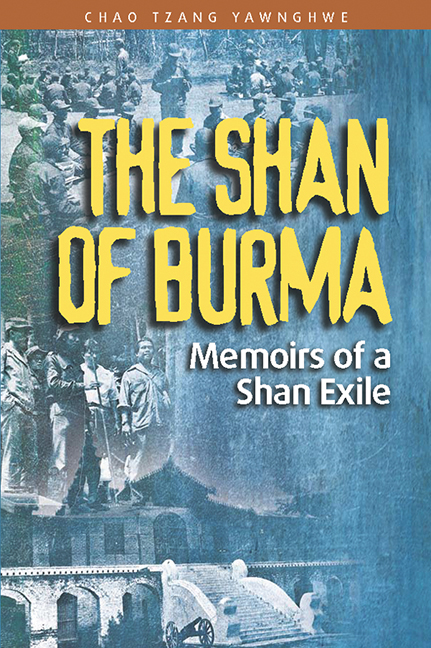Book contents
- Frontmatter
- Contents
- Foreword
- In Memorium
- Preface
- Acknowledgements
- PART ONE AN AUTOBIOGRAPHICAL INTRODUCTION
- PART TWO SHAN-BURMESE RELATIONS
- 2 An Overview of Shan-Burmese Relations
- 3 The Development of Shan-Burmese Relations
- 4 Shan-Burmese Relations from 1948
- PART THREE WHO'S WHO IN SHAN STATE POLITICS
- APPENDICES
- Abbreviations
- Glossary
- Bibliography
- Index
- The Author
3 - The Development of Shan-Burmese Relations
from PART TWO - SHAN-BURMESE RELATIONS
Published online by Cambridge University Press: 21 October 2015
- Frontmatter
- Contents
- Foreword
- In Memorium
- Preface
- Acknowledgements
- PART ONE AN AUTOBIOGRAPHICAL INTRODUCTION
- PART TWO SHAN-BURMESE RELATIONS
- 2 An Overview of Shan-Burmese Relations
- 3 The Development of Shan-Burmese Relations
- 4 Shan-Burmese Relations from 1948
- PART THREE WHO'S WHO IN SHAN STATE POLITICS
- APPENDICES
- Abbreviations
- Glossary
- Bibliography
- Index
- The Author
Summary
Shan or Tai Nationalism and the Burmese Centre
The relationship between the Shan or Tai and the Burmese power centre has always been long and turbulent, stretching back more than 900 years. Yet to the present day, the origins of the Shan are shrouded in mystery and surrounded by controversy. For instance, the ancient city of Tagaung which the Burmese claim to have established as their first capital is disputed by Shan and Tai chronicles which claim that by 568 A.D. the Tai, descendants of Khun Lun and Khun Lai, had founded a kingdom in Upper Burma with their capital at Muang Maorong in the same environ as the Burmese kingdom of Tagaung. The Burmese claim that their kingdom was founded during the life-time of the Lord Buddha, whilst the Shan claim that Tagaung is a Shan or Tai word, Ta-Gong, meaning “Drum Ferry” town.
Another controversy surrounding the early Shan (Tai/Thai) is the Nanchao question, and whether the “Ai-Lao” mentioned in early Chinese annals were Tai/Thai. Shan nationalists, and some historians subscribe very strongly to the theory that the Thai (Tai/Shan, or Siam), as the “Ai-Lao”, even before the Han, had established themselves between Tibet and the Chang Jian (Yangtze) River, a few thousand years ago. Later, they set up the Nanchao empire (650–1236) which together with China and Tibet, was a major power in the region for a time. According to this theory, some time before and immediately after Nanchao fell to Kublai Khan, the Shan or Tai (Thai/Siam) migrated south and westwards, founding Tai/Thai kingdoms in Assam (well established by 1229); in Upper Burma and present-day Shan State, the Tai Mao kingdom (well before 1215 to 1604); the kingdom of Ava in Central and Upper Burma (1287–1555); in Lower Burma, Wareru, the Shan son-in-law of Sukhothai's King Ramkhamheng (1275–1317) established the kingdom of Martaban; in present-day Laos, the Lan-Chang kingdom; in Vietnam, the kingdom of Sipsong Chu-Tai; and the kingdoms of Payao, Chiangsaen, Chiangmai, and Sukhothai in present-day Thailand, all founded well before 1238, except Chiangmai (in 1296).
- Type
- Chapter
- Information
- The Shan of BurmaMemoirs of a Shan Exile, pp. 62 - 90Publisher: ISEAS–Yusof Ishak InstitutePrint publication year: 2010



